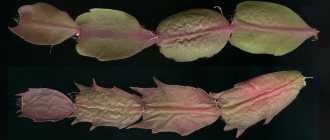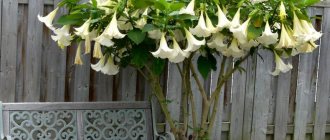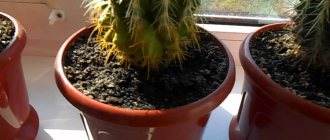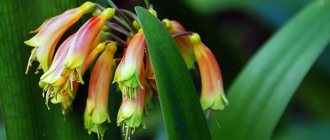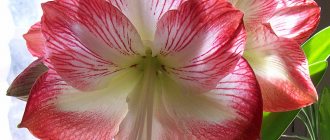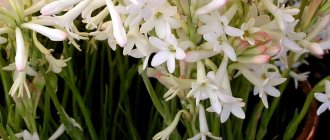- October 15, 2018
- Houseplants
- Natalia Michaelis
Callisia fragrant (popularly called golden mustache) is a houseplant that has healing properties, since its leaves and shoots contain phytosterols and flavonoids. Growing a golden mustache at home is not a particularly difficult task, but you still need to follow some recommendations and rules, which will be described below.
This plant is native to South America. The culture is called golden mustache due to the fact that it has a special leaf structure, which is penetrated by golden threads of vessels. Long shoots are called mustaches. At their crown, rosettes of leaves form, from which a new plant can be grown.
general description
Golden mustache flowers in the wild are creeping perennials that can reach two meters in height. Externally, this plant looks like an ordinary vine. When grown at home, golden mustache grows very slowly, and its height is a maximum of 40 cm.
However, a houseplant can grow up to one and a half meters in width. During growth, golden mustache flowers form shoots of two varieties: lateral and straight. They are covered with light green elongated leaf blades. Pinkish or white flower rosettes are formed at the ends of the shoots, which emit a pleasant aroma.
Contraindications
- The presence of a hypersensitive reaction - allergies (allergic dermatitis, exacerbation of bronchial asthma).
- Prostate adenoma.
- Kidney diseases.
- Pregnancy and lactation period.
- Minor children (under 12 years old).
- Individual intolerance.
Growing conditions
To successfully grow golden mustache at home, certain conditions must be created. However, this is not such a difficult matter. Growing golden mustache at home can be done in a greenhouse, apartment, conservatory, and in the summer it is permissible to keep the culture outside. However, you should pay attention to the fact that the flower is contraindicated in the kitchen. The fact is that smoke and air pollution negatively affect the state of the crop.
Lighting and temperature
The houseplant golden mustache is a heat-loving crop. The air temperature in the room during its cultivation should be about 25 degrees. In winter it should drop to 16 degrees.
In addition, the flower needs good lighting, but it should not be exposed to direct sunlight. Lighting should be diffused. Thanks to this, the color of the leaf plates will be a rich green hue with a purple tint on the bottom of the leaf. When keeping the golden tendril in direct sunlight, the leaves will turn purple.
Golden mustache requires unpretentious care at home, but the flower must be kept on an eastern or western windowsill. If the windows in the house face the south side, then under no circumstances should the culture be kept on this side. Speaking of care, it is also contraindicated to keep the golden mustache on the north side, otherwise the flower may suffer from lack of lighting and will not grow upward. In cloudy weather, the lack of light can be compensated with the help of special phytolamps that are installed above the flower. The backlight should be turned on for several hours a day for a golden mustache.
How to care for this plant at home? First of all, you should pay attention to the fact that this flower may suffer from cold air that comes from frosty windows. For this reason, some gardeners are faced with the problem of brown spots forming on the leaf blades.
Features of care after purchase
Growing a golden mustache at home also involves replanting and care after purchase. After purchase, the flower must be transplanted into a larger container, and fresh soil must be added. However, this procedure is not carried out immediately after purchase, but a week later, when the golden mustache has already adapted to the new growing conditions.
In order not to harm the root system, the plant must be removed from the old pot along with the earthen lump, then placed in a larger container and sprinkled with fresh soil on top. If an old pot shows signs of soil acidification, then it must be cleared of its roots and replaced completely. Rotten parts of the root system are cut off, and healthy parts are treated with a weak solution based on potassium permanganate.
Reproduction
The geniculate tendrils end in a rosette of leaves.
Callisia graceful reproduces well with green tendrils, which are used to produce new plants when they acquire a purple hue. The top of the geniculate shoot is cut off from the plant and rooted in soil or water. When planting a shoot in the ground, it is necessary to arrange a greenhouse, so rooting will take a shorter time. If you place the golden mustache in water for rooting, you must wait until roots form on the plant. Cuttings are planted in the ground when a root system up to 1-2 cm long is formed.
Soil composition
Golden mustache needs a loose nutrient substrate. You can easily prepare it yourself at home. But if possible, it is better to purchase such a composition ready-made in a specialized flower shop. To prepare your own soil mixture you will need 3 types of soil:
- Forest soil, which is taken from under deciduous trees, with the exception of birch.
- Rotted humus.
- River coarse sand.
The ingredients must be mixed in equal proportions. It is important to note that all types of soil must first be disinfected with a strong solution of potassium permanganate. It is recommended to rinse the river sand to remove any existing clay particles, and then calcine it in the oven or in a frying pan.
Availability
Fragrant callisia is often sold without tops, which have already formed aerial roots. They take root easily and grow quickly. In addition, buy callisia seeds or plants in pots or hanging baskets in specialized nurseries.
Spraying and watering
Golden mustache is very demanding on the level of soil moisture. The substrate should be kept slightly damp at all times. However, under no circumstances should you allow water to stagnate in the pot, so you need to put high-quality drainage at the bottom, for which you use pebbles, expanded clay or broken bricks.
The plants are watered abundantly, and the entire earthen ball is evenly moistened. Excess moisture is drained from the pan. It is recommended to water the flower in the morning. With the arrival of winter, watering is reduced, but you should not allow the substrate in the pot to dry out. The need to moisten the soil can be determined by the sound when knocking on the container. If the sound is ringing, then the soil is dry. A dull sound indicates soil moisture.
For irrigation, only settled water at room temperature is used. It is also recommended to slightly acidify the liquid, for which use 1 spoon of lemon juice or half a spoon of citric acid, which is diluted in a liter of water.
As for the air humidity in the room, it should be about 60%. If the air is drier, this may cause yellowing of the leaf plates. To maintain such humidity, it is necessary to spray the plant regularly. This procedure is especially relevant in winter, when the air is very dry due to the operation of heating devices. Additionally, during this period, you can place an artificial fountain next to the flower. But if this is not possible, then the pot with the plant should be placed in a tray with expanded clay, which is filled with water.
For spraying, melt water is used, which should first be frozen in the refrigerator. After this, it is defrosted and warmed to room temperature.
It is important to note that air humidity is much more important than the water content of the soil, since these are the conditions to which the crop is accustomed in the wild.
Fertilizer application
The most effective fertilizers for golden mustache are organic fertilizers. During transplantation, it is necessary to add humus or peat to the substrate, which is the main source of nitrogen. An alternative source of this element is ammonium nitrate, which is used during irrigation once every two weeks.
The plant also needs potassium and phosphorus. To prepare a nutrient solution, you need to take one and a half teaspoons of superphosphate, as well as half of the potassium salt. These ingredients are dissolved in 5 liters of water. It is necessary to feed the golden mustache throughout the growing season 2 times a month. Watering is carried out to the very roots. With the arrival of winter, the golden mustache does not need feeding.
Application in home cosmetology
In cosmetology, golden mustache is a popular plant. All kinds of products for the face, hands and hair are made from it, from its juice. There are recipes for single-component creams, but products with combined components are more effective. There is one preparation condition: the picked raw materials must be in the refrigerator before use. Next, various products are prepared using lanolin cream and olive oil.
Face cream recipe
- One teaspoon of plant juice + the same amount of aloe + the same amount of olive oil and honey.
- You will need 75 ml of cream with which all components are combined.
- The resulting mixture is stored in a cool place and used to apply to the face at night.
Hand cream recipe
- You will need 80 ml of hand cream, a teaspoon of golden mustache juice + the same part of olive oil + vitamin A oil solution.
- Everything is carefully mixed.
- Should be stored in a cool place.
- The cream should be used at night. Suitable for people with dry and rough hand skin.
Hair mask recipe
- You will need a spoon of freshly prepared ZU juice.
- The juice is poured into 1000 ml of boiled water.
- The mixture should infuse for a day.
- Use to rinse your hair after washing.
Toner recipe for dry skin
- Take a spoonful of juice and a spoonful of strawberry juice.
- The contents are mixed with a glass of water.
- Add half a spoonful of glycerin.
- Store in a cool, dark place.
- You can use the tonic both in the morning and in the evening.
Vegetative method
The vegetative method of propagation includes rooting rosettes of leaves or cuttings. To root the cutting, a shoot is taken. All leaves are removed from the bottom of this shoot, after which it is immersed in a glass of water for a couple of weeks. When the cuttings have roots, it should be placed in a container with soil. It is immersed in the soil to the level of the first leaves to form new roots. The breeding season using this method lasts from March to April.
You can also root a golden mustache using rosettes with leaves. As a rule, they form at the tops of shoots. They must be separated from the shoot using a sharp knife, leaving part of the base of the stem on the rosette. The cut planting material is placed in a container that is filled with water. The fluid in it must be changed every two days. As a rule, the first roots will appear within 2 weeks.
You can also propagate golden mustache at home by dividing the bush. However, it is worth paying attention to the fact that the shoots of this plant quite often bend and take root on their own. If you separate such an established rosette, you can easily get a new specimen.
The healing properties of the golden mustache
The golden mustache is often called a panacea for all diseases. He restored lost health to many people. In alternative medicine it is used to normalize digestion, circulatory system and respiratory functions.
It is successfully used to improve immunity. For skin diseases, arthritis, arthrosis, the oil of this plant is used. Rubbing an alcohol tincture brings relief from joint pain.
Medicinal preparations are made from leaves, trunk and liana-like shoots. Callisia juice has a wound-healing, disinfectant and regenerating effect.
All parts of the golden mustache have medicinal properties except the roots. The medicinal properties of the plant appear after at least nine “joints” are formed on the long shoots and they acquire a brownish-purple color.
Despite all the positive qualities of the golden mustache, it should still be borne in mind that its chemical composition and side effects have not yet been fully studied.
Particular care should be taken when used internally. Golden mustache should be used internally under the supervision of a herbalist.
Callisia has disinfectant properties - it purifies the air around it. Decoctions prepared from leaves and mustaches do not sour for several days.
Read more about the medicinal properties of the plant, how to prepare ointment, oil and alcohol tincture in the article https://dobro.pw/zolotoj-us-lechebnye-svojstva-i-protivopokazaniya/
Possible pests and diseases
When growing golden mustache at home, the plant may develop pests, such as spider mites or thrips. They attack the flower only if the air in the room is too dry. To combat these insects, it is necessary to use systemic insecticides designed specifically for indoor plants (Iskra, Aktara, Fufanon).
The roots of the plant can be affected by mealybugs. The larvae of these insects enter the pot along with the soil, and if there is excessive moisture, they actively develop. As these pests develop, a white coating forms on the leaves, which looks like pieces of cotton wool. If signs of this pest appear, the plant must be wiped with a soapy solution, and then sprayed with an insecticide: “Fitoverm” or “Biotlin”.
If the tips of the leaves begin to dry out and brown spots appear on the leaf blades, this indicates a lack of water or excess sunlight.
Rotting of the lower leaves occurs due to waterlogging of the soil or too low air temperature in the room.
In general, if you follow all the recommendations and rules for caring for and growing golden mustache, this plant will be able to please the eye of its owner and become a wonderful interior decoration.

